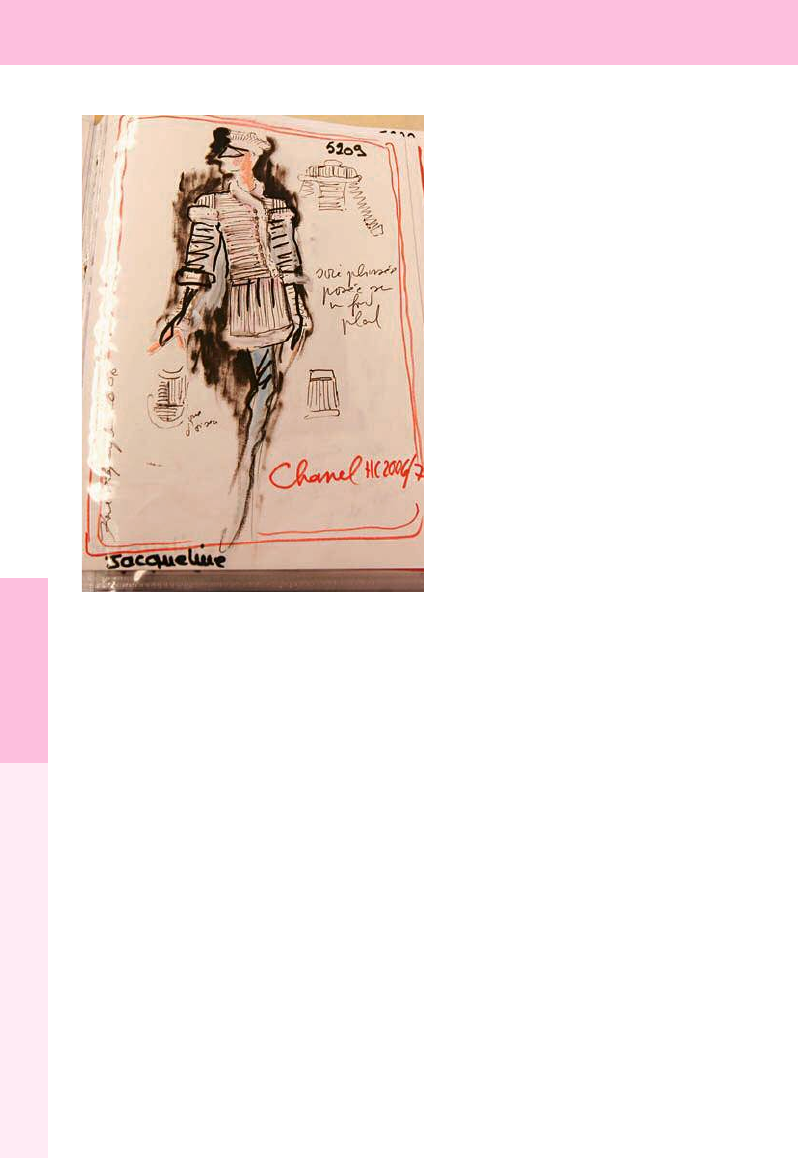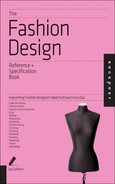
Job:02-30034 Title:RP-Fashion Design Ref and Spec Book
#175 Dtp:225 Page:158
146-161_30034.indd 158 2/27/13 3:01 PM
15 8 THE FASHION DESIGN REFERENCE + SPECIFICATION BOOK
(Text)
14
TYPES OF RENDERINGS
Classic mid-1920s fashion illustration by Georges Barbier
The Bridgeman Art Library/Getty Images.
Fashion Illustration
A fashion illustrator is not a fashion designer, although a fashion designer can be an illustra-
tor. Fashion illustrations fall under a separate category more closely aligned with advertising.
This kind of fashion rendering is the work of artists who are skilled at conveying the messages
and fantasies behind the fashion. Everything from fine art techniques to animation-inspired
graphics can be used to create a mood around a style. Photography has for a long time over-
powered fashion illustration as the method for communicating fashion, but more and more
fashion artists are being sought after for their unique interpretations. The line between illus-
tration and photography is also blurring, thanks to computer technology. With a photograph as
the foundation, an image can be taken to new heights by a talented computer artist.
Fine art style illustration by Catherine Abel
The Bridgeman Art Library/Getty Images.
ZZVE Illustrations/Getty Images.
Job:02-30034 Title:RP-Fashion Design Ref and Spec Book
#175 Dtp:225 Page:158
146-161_30034.indd 158 2/27/13 3:01 PM

Job:02-30034 Title:RP-Fashion Design Ref and Spec Book
#175 Dtp:225 Page:159
Book
e:158
146-161_30034.indd 159 2/27/13 3:02 PM
Rendering 15 9
(Text)
14
s
s
The Bridgeman Art Library/Getty Images.
Graphic style illustration by Eastnine Inc.
ZZVE Illustrations/Getty Images.
Job:02-30034 Title:RP-Fashion Design Ref and Spec Book
#175 Dtp:225 Page:159
Book
e:158
146-161_30034.indd 159 2/27/13 3:01 PM

Job:02-30034 Title:RP-Fashion Design Ref and Spec Book
#175 Dtp:225 Page:160
146-161_30034.indd 160 2/27/13 3:02 PM
16 0 THE FASHION DESIGN REFERENCE + SPECIFICATION BOOK
(Text)
14
D
D
a
of
fa
a
a
In
m
a
m
D
a
a
O
e
m
D
o
s
re
by
a
Workroom sketch by Karl Lagerfeld
for the Chanel Haute Couture Fall/Winter
2006/2007 Collection
Photograph by François Durand/Getty Images.
Sketching Shorthand
Many designers develop a kind of notation for a bare-bones framework that allows them to jot
down fashion ideas. This can be akin to a stylized stick figure that they use to create rough
pictures of scale, proportion, length, and detail. Whether the idea is captured on a napkin or
in a notebook, the fashion scribble is a way to make visual notes. The images might also be
accompanied by details and descriptions that allow the designer to revisit them and develop
more elaborate renderings.
Techs
Technical fashion sketches can be done by hand, but computer-generated techs have become
an industry standard. These sketches are designed to provide more detailed specifications
about the actual garments. These simple line drawings are also called flats because they are
drawn like clothing lying flat rather than on a figure. This type of fashion drawing is also used
on the cutting tickets that accompany a garment during production or on line sheets with infor-
mation required by buyers.
Job:02-30034 Title:RP-Fashion Design Ref and Spec Book
#175 Dtp:225 Page:160
146-161_30034.indd 160 2/27/13 3:01 PM

Job:02-30034 Title:RP-Fashion Design Ref and Spec Book
#175 Dtp:225 Page:161
Book
e:160
146-161_30034.indd 161 2/27/13 3:02 PM
Rendering 161
(Text)
14
Digital Art
Designers can create digital fashion sketches using computer art software. Adobe Photoshop
and Adobe Illustrator are two mainstream programs that serve as excellent digital interpreters
of the drawing skills a designer develops in the real world. All of the techniques described for
fashion sketches created by hand can be recreated using the on-screen tools, layers, brushes,
and filters. Many types of software designed specifically for the needs of a fashion designer
are now available. Of course, none of these programs is a substitute for learning how to draw.
In the end, a computer and software are just tools like a brush and a pencil. Either discipline
must be mastered to produce great images. The advantage of digital art is that it’s cleaner
and paperless, and it allows the designer to update, correct, and reproduce visual information
more easily and quickly.
Designing textiles with software that can communicate with looms and knitting machines is
another practical use of technology. This type of program allows the designer to create woven
and knit fabrics by coloring each warp and weft thread as well as every knit and purl stitch.
Other programs allow the designer to scan in a swatch of a fabric that they may have discov-
ered but that is no longer available. Designers can clean up the scan, then reduce a print to a
motif that they can recreate, redesign, or recolor according to how it will best serve their idea.
Draping software makes it possible for designers to create textured surface grids for sketches
or photographs of sample garments. They can then assign their digital fabric designs to these
surfaces. A picture is worth a thousand words when attempting to describe how a garment will
read when fabricated in different textiles. The whole process allows designers to reduce risk
by extending a menu of possibilities to a buyer before committing to the production of fabrics
and garments.
Draped muslin and
draped muslin with
computer-generated
fabric
Photographs by Tracy Aiguier.
t
e
r-
Job:02-30034 Title:RP-Fashion Design Ref and Spec Book
#175 Dtp:225 Page:161
Book
e:160
146-161_30034.indd 161 2/27/13 3:01 PM
..................Content has been hidden....................
You can't read the all page of ebook, please click here login for view all page.
